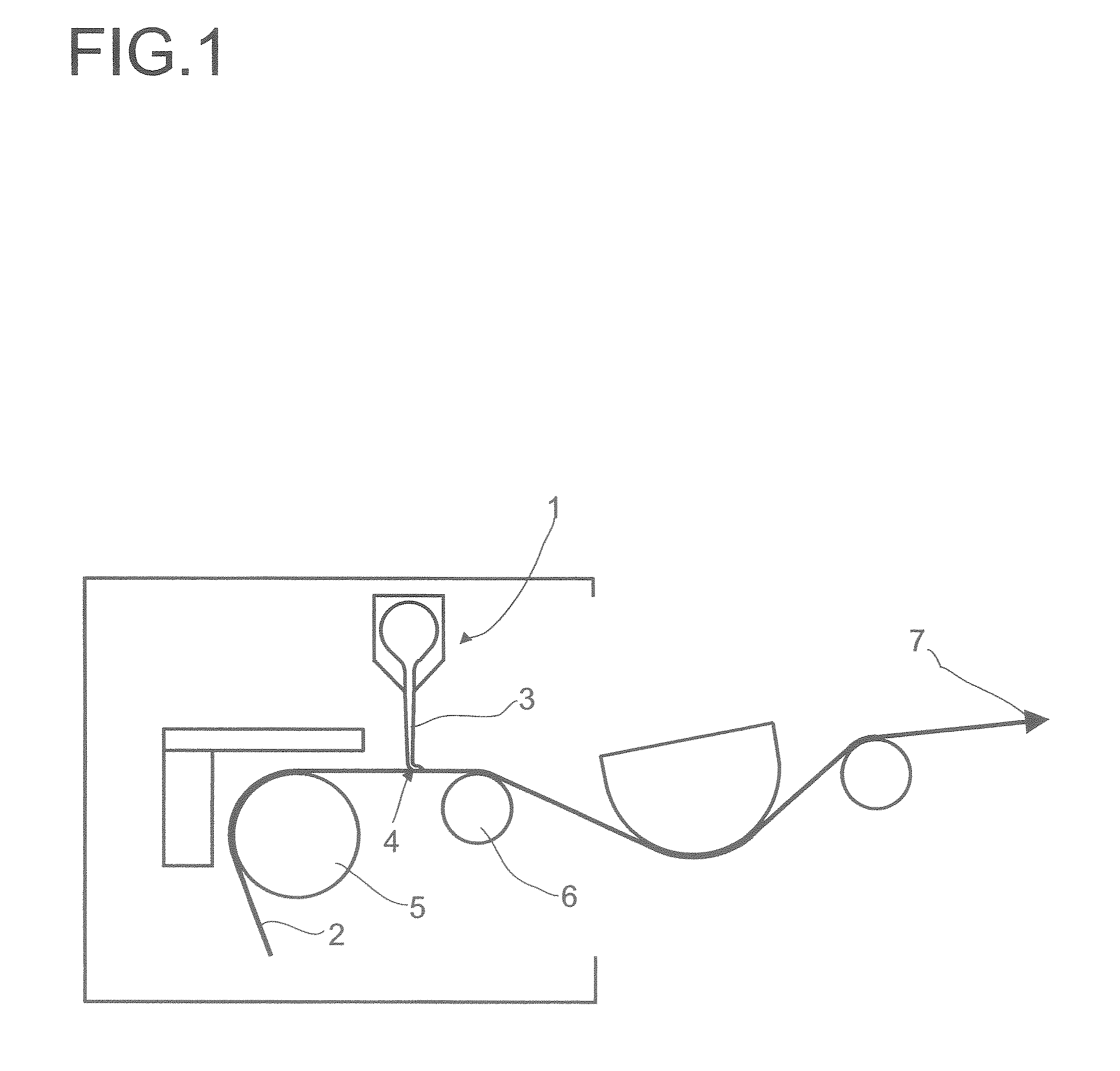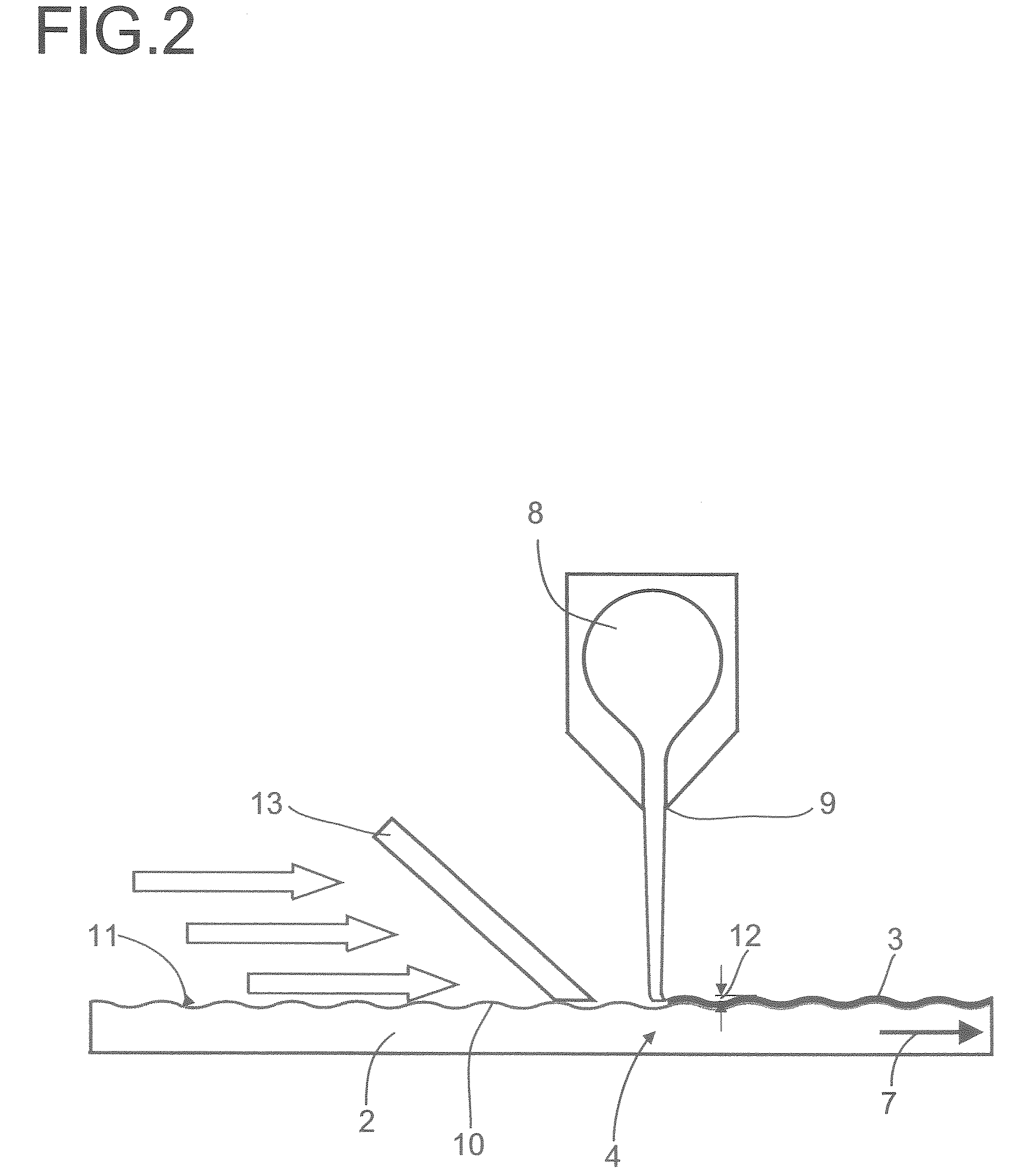Method for the Production of Single-and/or Multiple-Coated Substrates
a technology of multiple coatings and substrates, applied in the field of single and/or multiple coating methods, can solve the problems of affecting the quality of coated paper, affecting the quality of paper and cardboard, and slow coating speed, and achieve the effect of expanding the range of curtain coating methods
- Summary
- Abstract
- Description
- Claims
- Application Information
AI Technical Summary
Benefits of technology
Problems solved by technology
Method used
Image
Examples
example 1
[0177]The formulation with the number 1 was applied to a wood-free 70 g / m2 base paper by means of a simple curtain coating on the substrate in a coat weight 20 g / m at a paper web speed of 1200 m / min. Furthermore, at a constant volume flow rate, the paper web speed was increased in each case to 1400, 1600 and 1800 m / min so that the test points reproduced in table 2 below resulted.
TABLE 2Overview of example 1Paper web speedCoat weightExampleFormulation(m / min)(g / m2)1a11200201b1140017.11c11600151d1180013.3
[0178]The results obtained are summarized in table 3 below,
TABLE 3Overview of results from examples 1a, 1b, 1c and 1dExample1a1b1c1dSmoothness1.731.571.661.83IGT (cm / s)125137139138Prüfbau Offset555510 s(passes to fail)Coat defectsnonenonemanymany
[0179]The results shown in table 3 show that very many coat defects occur at web speeds of 1400 m / min, with otherwise good paper properties.
example 2
[0180]The formulation number 2 according to the list shown in table 1 “Overview of the formulations” was applied to a wood-free 70 g / m2 base paper by means of simple curtain coating on the substrate with a coat weight of 20 g / m2 at a paper web speed of 1200 m / min. Furthermore, at a constant volume flow rate, the paper web speed was increased in each case to 1400, 1600 and 1800 m / min so that four test points were established altogether, as compared with one another in table 4.
TABLE 4Overview of example 2Paper web speedCoat weightExampleFormulation(m / min)(g / m2)2a21200202b2140017.12c21600152d2180013.3
[0181]The results for the formulation 2 at paper web speeds of 1200 to 1800 m / min and decreasing coat weight of the coating slip to be applied are summarized in table 5.
TABLE 5Overview of results for examples 2a, 2b, 2c and 2dExample2a2b2c2dSmoothness1.391.431.631.93IGT (cm / s)142143156153Prüfbau Offset555510 s(passes to fail)Coat defectsnonenonemanymany
[0182]The results listed in table 5 s...
example 3
[0183]The formulation of the coating slip according to number 3 (cf. overview according to table 1) was applied to a wood-free 70 g / m2 base paper by means of simple curtain coating on the substrate to be processed with a coat weight of 20 g / m at a paper web speed of 1200 m / min. Furthermore, at constant volume flow rate of the coating slip according to formulation number 3. the paper web speed of 1200 m / min was increased in each case to 1400, 1600 and 1800 m / min so that, analogously to example 1 and example 2, four test points resulted, which are compared with one another in table 6 below.
TABLE 6Overview of example 3Paper web speedCoat weightExampleFormulation(m / min)(g / m2)3a31200203b3140017.13c31600153d3180013.3
[0184]The results obtained are shown in table 7 below.
TABLE 7Overview of results for examples 3a, 3b, 3c and 3dExample3a3b3c3dSmoothness1.461.551.561.61IGT (cm / s)158142148151Prüfbau Offset555510 s(passes to fail)Coat defectsnonenonenonenone
[0185]The results listed in table 7 s...
PUM
| Property | Measurement | Unit |
|---|---|---|
| Fraction | aaaaa | aaaaa |
| Fraction | aaaaa | aaaaa |
| Fraction | aaaaa | aaaaa |
Abstract
Description
Claims
Application Information
 Login to View More
Login to View More - R&D
- Intellectual Property
- Life Sciences
- Materials
- Tech Scout
- Unparalleled Data Quality
- Higher Quality Content
- 60% Fewer Hallucinations
Browse by: Latest US Patents, China's latest patents, Technical Efficacy Thesaurus, Application Domain, Technology Topic, Popular Technical Reports.
© 2025 PatSnap. All rights reserved.Legal|Privacy policy|Modern Slavery Act Transparency Statement|Sitemap|About US| Contact US: help@patsnap.com



